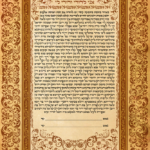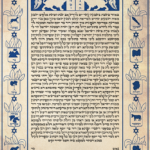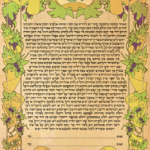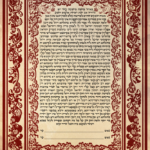Historical
-
The Modena Italian Ketubah
$290.00
The Jews of Modena were the bankers (under the protection of the House of Este) and scribes, particularly the Kabbalistic scribes, since 1025. The Jewish tradition of Modena is rich and varied: the Jews were expelled from Bologna and other parts of Italy and escaped to the safety of Modena; yet Modena still required a Ghetto. They were the heart of the “Italkim,” the Jews of Italy.The tradition of the Ketubot from Modena is one of the greatest remaining gifts to modern Jewry from Modena. The Ketubot of Modena were elegant yet embellished — a perfect combination representing the ups-and-downs of the traditional Jewish life in Modena.The Modena Ketubah incorporates the elaborate details of the southern Sephardi Jews — and applies it to a more traditionally Ashkenazim format, where a simple frame holds the text. The use of one single color was popular in the early sixteenth century, as pigments were scarce, and the color red was the most appropriate option when writing on parchmentSee This Ketubah See This Ketubah
-
The Bucharest Ketubah
$290.00
Jews have been living in Romania since the 16th century; first the Jewish Turkish merchants first settled there, followed by waves of Ashkenazim over the centuries. The Jews of Bucharest have both suffered misfortunes and flourished profoundly at different eras during the last half-millennium in and around Bucharest, Moldovia and Walachia.
The Romanian Jewish tradition of Ketubah art is one of the best of the European and Ashkenazi Jews. The Ketubot of Bucharest often traditionally included references to the twelve tribes of Israel (such as the names and symbols of the 12 tribes aligning the columns of the Bucharest Ketubah) and the blue that is now so powerfully associated with Judaism.
See This Ketubah See This Ketubah -
The Viennese Ketubah
$290.00
The Jews flourished in Vienna during the height of the Austro-Hungarian empire — despite a history of Jewry in Vienna that is filled with high highs, and low lows — and still today, the Jews of Viennese descent tend to retain one of the strongest connection to the country, as compared to most other Jewish emigrant groups.The Jewish culture of Vienna was famously intellectual — birthplace of Wittgenstein, Popper, and endless Jewish-Viennese intellectuals — the Ketubot of Vienna reflected that tradition. Unlike the Sephardi ketubot, which were decorated with flair, the Viennese Ketubot tended to be viewed as Legal Contracts. Thus, they were, aristically, among the most reserved and conservative ketubot. Yet they do retain a very distinctive style, often framed, in the art, by the seven species and Jewish symbols such as the Magen David. But the framing is always simple, and with minimal colors; an understated elegance.See This Ketubah See This Ketubah
-
The Russian Ketubah
$290.00
The Jews of Russia and the Pale of Settlement have historically had a distinctive style of Ketubah. Not nearly as ornamental as the Sephardi Ketubot, these Ashkenazi Ketubot were usually simpler and often very humble. The best of them include slight and subtle flair and deep red colors.
The Russian Ketubah is perfect for the Jewish couple who wants a Ketubah in the traditional style of our ancestors in Eastern Europe, honoring and remembering their lives and traditions.
See This Ketubah See This Ketubah





